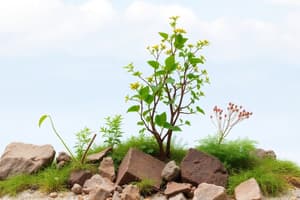Podcast
Questions and Answers
Which of the following is an example of a renewable resource?
Which of the following is an example of a renewable resource?
- Fossil fuels
- Water (correct)
- Coal
- Recyclable metals
What classification refers to resources that can be owned by a group rather than an individual?
What classification refers to resources that can be owned by a group rather than an individual?
- Community ownership (correct)
- Potential stock
- National ownership
- Individual ownership
Which of the following is NOT considered a part of natural resources?
Which of the following is NOT considered a part of natural resources?
- Wildlife
- Structures and institutions (correct)
- Biological resources
- Continuous flow resources
What type of resource is classified as having the potential for future development yet is not currently utilized?
What type of resource is classified as having the potential for future development yet is not currently utilized?
Which of the following correctly identifies biotic resources?
Which of the following correctly identifies biotic resources?
Flashcards
Biotic Resources
Biotic Resources
Resources derived from living organisms such as plants and animals.
Abiotic Resources
Abiotic Resources
Resources obtained from non-living sources like rocks, minerals, and air.
Renewable Resources
Renewable Resources
Resources that can be replenished naturally over a short period, like solar energy, wind, and water.
Non-renewable Resources
Non-renewable Resources
Signup and view all the flashcards
Potential Stock
Potential Stock
Signup and view all the flashcards
Study Notes
Resources and Development
- Resources are things available in the environment that can meet needs.
- Resources are not simply gifts of nature; they are related to human activities.
- Humans transform natural resources and use them through technology and institutions.
- Resources can be classified in various ways:
- By origin (biotic or abiotic)
- By exhaustibility (renewable or non-renewable)
- By ownership (individual, community, national, international)
- By development status (potential, developed stock and reserves)
Classification of Resources (Fig. 1.2)
-
Natural Resources:
- Renewable:
- Continuous flow resources (e.g., wind, water)
- Biological (e.g., vegetation, forests)
- Wildlife
- Non-Renewable:
- Biological resources that take a long time to replenish (e.g., biological and minerals)
- Recyclable (e.g., metals)
- Non-recyclable (e.g., fossil fuels)
- Renewable:
-
Human Resources:
- Structures and institutions
- Quantity and quality
-
Interrelationships Between Nature, Technology, and Institutions (Fig. 1.1):
- Nature, technology, and institutions are interconnected
- Technology allows interaction between people and nature leading to economic development of societies
Studying That Suits You
Use AI to generate personalized quizzes and flashcards to suit your learning preferences.




